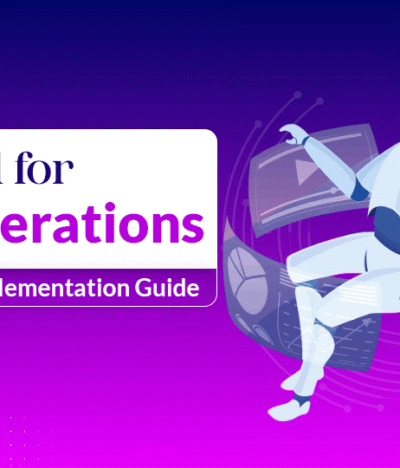As a Head of Customer Experience or Operations in the BPO industry, you’re not just looking for the latest tech buzzwords. You’re under constant pressure to deliver on three critical fronts: elevating customer satisfaction (CSAT/NPS), optimizing operational costs, and ensuring scalable, resilient operations.
The conversation around AI in the BPO industry is often filled with hype. This article cuts through the noise. We provide a strategic framework for evaluating and implementing AI—specifically in customer support and call center automation—to achieve tangible business outcomes that matter to you.
The Strategic Imperative: Why AI is Non-Negotiable for Modern BPOs
For you, AI isn’t a “nice-to-have”; it’s a core strategic lever. The traditional model, heavily reliant on human labor for volume-based tasks, is increasingly unsustainable due to:
- Rising Labor Costs and Attrition: High agent turnover directly impacts training costs and service consistency.
- Demand for Hyper-Personalization: Clients and their end-customers expect tailored interactions, not one-size-fits-all scripts.
- Pressure on Margin: The need to deliver higher-value services without a proportional increase in cost.
- Data-Rich, Insight-Poor Environments: You have vast amounts of interaction data, but extracting actionable intelligence is a challenge.
A Targeted Approach: Where AI Delivers Immediate ROI for BPOs
Focusing on the areas with the highest impact is key. Here’s how to strategically deploy AI in your operations.
1. Augmenting the Agent Ecosystem for Superior CX
The goal is not to replace your workforce but to augment it. Equip your agents with AI to make them more effective and fulfilled.
- Real-Time Agent Assist: Imagine an AI co-pilot that listens to calls and instantly surfaces relevant knowledge base articles, compliance guidelines, and next-best-action suggestions. This reduces handle time (AHT), improves first-contact resolution (FCR), and enhances agent confidence.
- Proactive Sentiment Analysis: Move from reactive to proactive service. AI that analyzes customer tone in real-time can alert supervisors to at-risk interactions, allowing for intervention before dissatisfaction escalates, directly protecting your CSAT scores.
- Automated Post-Call Work: AI can automatically summarize calls, update CRMs, and tag cases, freeing up to 20% of an agent’s time from administrative tasks. This directly boosts productivity and allows agents to focus on what they do best: building rapport.
2. Mastering Scalability with Intelligent Call Center Automation
Call center automation is evolving from simple IVRs to intelligent, conversational systems that manage complexity.
- Tier-0 Resolution with AI Voicebots: Deploy sophisticated voicebots to handle common, repetitive inquiries (balance checks, appointment scheduling, password resets) 24/7. This deflates call volume, reduces wait times, and allows your human agents to focus on high-value, complex issues.
- Predictive Routing: Go beyond skills-based routing. Use AI to analyze customer history and real-time intent to connect them with the best-suited agent, considering personality matching and historical success rates with similar cases. This increases resolution rates and customer satisfaction.
The Operational Leader’s Checklist for AI Implementation
Before investing, use this framework to assess potential AI solutions:
- Identify a Specific Pain Point: Don’t boil the ocean. Start with a targeted goal: “Reduce AHT by 10%” or “Improve FCR in our tech support vertical.”
- Evaluate Integration Capabilities: Will the AI tool seamlessly integrate with your existing CRM, ticketing systems, and UCaaS platforms? Complexity is the enemy of adoption.
- Demand Transparency on Data Security: For BPOs, data security is paramount. Scrutinize the vendor’s security protocols, compliance certifications (SOC 2, ISO 27001), and data governance models.
- Plan for Change Management: How will you train your agents and teams? A top-down mandate will fail. Position AI as a tool that makes their jobs easier and more strategic.
- Define Clear KPIs: How will you measure success? Tie AI implementation directly to metrics you already track:
- Efficiency: AHT, Cost per Contact, FCR
- Quality: CSAT, NPS, Quality Assurance Scores
- Employee Engagement: Agent Attrition, Net Promoter Score (eNPS)
The Bottom Line: From Cost Center to Value Creator
For strategic leaders, the integration of AI in the BPO industry is the pathway to transforming your operation from a cost center into a strategic, value-creating partner for your clients. It’s about doing more than managing volume—it’s about delivering insights, driving efficiency, and creating exceptional customer experiences that drive retention and growth.
Strategic Self-Assessment for Leadership
On a scale of 1-5, how prepared is your operation for AI integration?
- Awareness: We understand AI but lack a clear implementation strategy.
- Planning: We are currently evaluating vendors and use cases.
- Piloting: We are running a limited proof-of-concept in one LOB.
- Scaling: We have successfully piloted AI and are planning expansion.
- Optimizing: AI is core to our operations, and we are focused on continuous improvement.
Ready to Build Your AI Roadmap?
Theoretical understanding is the first step. Building a concrete, actionable plan is what delivers results.
Your Next Step: A Data-Driven Strategy Session
Let’s move beyond the generic. Schedule a dedicated session with our BPO transformation specialists.
In this session, we will:
- Analyze your specific operational data and customer interaction flows.
- Identify the top 2-3 AI use cases with the highest potential ROI for your business.
- Outline a phased implementation plan designed to minimize risk and maximize impact.
For fellow leaders: What is the single biggest operational hurdle you believe AI can help you overcome? Share your perspective in the comments below.




